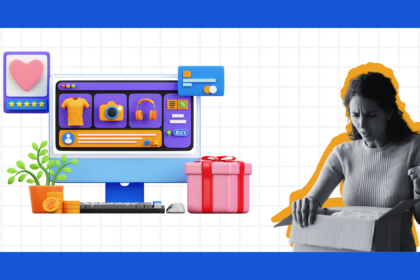Why Prioritizing Acquisition over Retention May Not Be the Best Move to Make When It Comes to Building a Customer Base
‘X’ is an e-commerce company that deals with fast fashion and focuses only on acquiring new customers through heavy discounting and advertising. While they may see a spike in new customer acquisition, they may also see a high rate of customers who only make one purchase and never return. The same company decides to change its approach and begin focusing on retaining its customers through a great post-purchase experience and loyalty program.
In the first case, there is a constant need for more marketing spending to acquire new customers and a lower lifetime value from each customer. Whereas, in the second, they may see a decrease in customer churn rate and an increase in repeat purchases. Over time, this also results in a more stable and profitable customer base, with a higher lifetime value from each customer.
Thus, it is clear that while acquiring new customers is important, retaining existing ones is often more profitable and cost-effective in the long run. Thus, e-commerce brands must start prioritizing customer retention over acquisition, as it is the best move to make.
Still not convinced? Here are some metrics that speak for themselves.
Importance of a customer base
Here are some key metrics on the importance of customer loyalty in e-commerce:
- Repeat customers are more valuable: According to Hubspot, repeat customers spend 67% more on average compared to new customers.
- Increased customer lifetime value: Shopify found that customers who make repeat purchases have a higher lifetime value compared to one-time customers.
- Lower acquisition costs: Acquiring a new customer is often more expensive than retaining an existing one. It costs 7 times more to acquire a new customer compared to retaining an existing one.
- Increased NPS (Net Promoter Score): Satisfied and loyal customers are more likely to refer others to the e-commerce business, resulting in more new customers.
Now that it is clear why retention needs to be prioritized over simply spending on acquiring new customers, let’s move on to the focus of this article ‘building a customer base with post-purchase strategies’. But before that, here comes a harsh truth — customer loyalty efforts in the post-purchase aren’t as easy as it is in the pre-purchase phase.
Why, you ask? Here’s why.
Why Do Efforts to Build a Customer Base Take a Hit in the Post-purchase Phase?
Building a customer base can take a hit in the post-purchase phase for several reasons, with the priority being the lack of control over the post-purchase phase itself.
E-commerce businesses, who do a lot to make their customers hit buy, intentionally cut off almost all communication with their customers once the order is dispatched and handed over to the shipping carrier. This lack of communication results in a feeling of neglect. Also, a lack of follow-up in the post-purchase prevents businesses from knowing what the customer really feels about their purchase and makes any room for improvements near-impossible.
Adding fuel to the fire is the occurrence of post-purchase issues such as shipping delays, damaged products, poor customer service, etc. Even in cases where nothing goes wrong, unmet expectations and customers feeling unvalued can lead to decreased customer satisfaction.
All of this can ultimately lead to negative post-purchase experiences and cause the customer to end ties with the business. On the other hand, a great post-purchase experience can help build a better brand reputation and increase customer trust.
Thus, it’s important for e-commerce businesses to focus on post-purchase experiences, to protect all their loyalty efforts in the pre-purchase from going to waste.
Post-purchase CX Strategies to Build a Customer Base
1. Proactive support workflow with real-time package data and predictive analytics
A proactive support workflow with real-time package data and predictive analytics can greatly enhance the customer experience in the following ways:
With real-time data at hand, brands stand to gain predictive analytics that gives them the ability to detect potential issues before they arise and take pre-emptive measures to resolve problems, leading to a seamless post-purchase experience for customers.
Also, comprehensive insights into customers’ package data allow e-commerce businesses to provide more personalized support to customers, addressing their specific needs and concerns.
2. Reduced customer anxiety and increased repeat purchases with customized post-purchase email and SMS flow
Today’s customers are increasingly invested in their online orders, leading to pre-parcel anxiety. Thus, even in cases when nothing goes wrong, their feelings can cause post-purchase dissonance.
To avoid this, brands must look forward to sending post-purchase emails and SMS that can provide customers with order confirmations and other shipping updates/delivery notifications, which can reduce anxiety and increase trust.
Also, proactive communication regarding the order status can reduce the number of customer inquiries and free up customer service resources for more complex issues.
Brands can also increase the capabilities of post-purchase emails by providing customers with relevant information such as product usage tips, follow-up surveys, and upsell/cross-sell opportunities, thus increasing the chances of repeat purchases.
3. Convert order tracking moments into marketing opportunities by building own, customized branded tracking pages
Apart from providing quality experiences, e-commerce businesses can also improve retention rates by spurring customers to spend more via marketing opportunities during order tracking moments.
Instead of sending customers to the carrier’s tracking page, brands can build their own, customized branded tracking pages, that allow e-commerce businesses to create a consistent and cohesive customer experience and reinforce the brand identity.
These tracking pages and promotional emails can include cross-selling opportunities, such as product recommendations to encourage customers to make additional purchases and relevant information such as reviews, relevant support channels, etc, to build trust and instill confidence in customers
Additionally, tracking pages can also be linked to Google analytics to track customer behavior, which in turn can be used to increase customer engagement and build stronger relationships with their customers.
In conclusion, by building customized branded tracking pages, e-commerce businesses can turn order-tracking moments into marketing opportunities, increase customer engagement, and drive repeat purchases.
4. Perfect the post-purchase strategy with consolidated data and better decisions
Despite following all of the strategies mentioned above, meeting customer expectations when it comes to post-purchase experiences can still be difficult. This happens because of two reasons: One, customer demands are dynamic and ever-increasing with technological advancements. Two, post-purchase issues are inevitable and at times happen outside anyone’s control.
In such cases, a simple assurance of improvement to consumers can help in not just meeting but even exceeding customer expectations. And the key to doing that is to perfect the post-purchase strategy. Here’s how e-commerce businesses can do the same.
- Gain actionable insights in the form of customer feedback on delivery experiences to decode customer actions and improve post-purchase CX over time.
- Understand details of your shipping spending to make critical cost-saving decisions and informed shipping choices.
- Track carrier performances across services and geographical locations to uncover gaps and take better decisions.
Making regular improvements to provide a better post-purchase experience, in turn, helps to increase customer satisfaction and loyalty in the long run. Also, informed shipping decisions can improve shipping operations and reduce costs.
5. Craft a returns experience so good that customers feel confident in the brand
The last but not the least aspect while dealing with post-purchase strategies is to handle returns efficiently and craft a returns experience that builds customer confidence and ensures that the customer returns to shop with the business despite returning their previous purchase.
The reason for a valid return can be anything but in most cases, it is simply due to the customer not being completely satisfied with the product received. Such customers would already be feeling low, having to return their purchase (which they’ve anticipated long to get on their hands). Making the return process complicated for them, can infuriate them further and prevent any chance of making a sale.
Here’s where a straightforward returns process can be key in reducing customer angst and building confidence. This can include offering convenience via prepaid return shipping labels to reduce friction, clear instructions on how to initiate a return, and a minimal process with a reduced requirement of support reps’ help.
Also, similar to order deliveries, providing regular updates on the status of a return can help reduce anxiety and assure customers that their returned order has safely made it back to the warehouse.
While that is on the customer front, e-commerce businesses can also promote exchanges and store credits over refunds in the event of a return. Not only this encourages repeat purchases but also ensures cost-saving.
Before all of that, keep in mind that the trick to a great return experience starts even before an order is placed. Being transparent about the returns policy and process creates a positive first impression on your customers as they’re looking to make a purchase.
Final Word
In conclusion, building a customer base through a positive post-purchase experience is crucial for e-commerce businesses.
By prioritizing customer satisfaction and offering a seamless returns process, proactive support with real-time data and predictive analytics, customized post-purchase emails and SMS flows, and a branded order tracking page, businesses can increase customer loyalty and repeat purchases.
The effort put into perfecting the post-purchase strategy can pay off in increased customer satisfaction and long-term growth for the business. It’s important to understand the value of customer loyalty and the role post-purchase experience plays in it and make it a priority in the overall e-commerce strategy.
If you’re looking for a one-stop solution for everything post-purchase, here’s LateShipment.com for you.
How LateShipment.com Powers Post-purchase Success
LateShipment.com is the world’s only all-in-one post-purchase success platform for e-commerce retailers, D2C brands and businesses shipping small parcels, no matter their size or shipping volume.
Our Post-purchase Success platform includes:
Delivery Experience Management (DEM): To build memorable order delivery experiences and boost recurring revenue during order tracking moments.
Returns Experience Management (REM): To make returns hassle-free with flexible return options and smart automations to help retain revenue.
Parcel Audit and Shipping Refunds: To save big on shipping costs through automated shipping refunds and drive supply-chain optimization with in-depth shipping analytics and insights.
LateShipment.com also seamlessly integrates with 600+ Shipping Carriers and Business Tools that include E-commerce platforms, Order Management Systems, Helpdesks, and Marketing Automation tools to help you drive post-purchase experiences and shipping cost savings, at scale.






